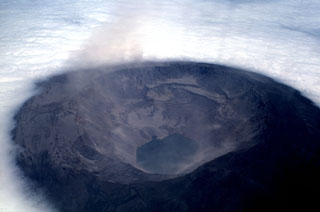Report on Fernandina (Ecuador) — March 1977
Natural Science Event Bulletin, vol. 2, no. 3 (March 1977)
Managing Editor: David Squires.
Fernandina (Ecuador) Fissure lava eruption during 23-27 March
Please cite this report as:
Global Volcanism Program, 1977. Report on Fernandina (Ecuador) (Squires, D., ed.). Natural Science Event Bulletin, 2:3. Smithsonian Institution. https://doi.org/10.5479/si.GVP.NSEB197703-353010
Fernandina
Ecuador
0.37°S, 91.55°W; summit elev. 1476 m
All times are local (unless otherwise noted)
A four-day eruption began 23 March from fissures at the SE end of Fernandina caldera. As in the similar eruptions of 1972 and 1973, lava flowed down the inner caldera wall into the large (2-km-diameter) caldera lake. The following report is compiled largely from information provided by Dagmar Werner and the Charles Darwin Research Station (CDRS).
A red glow over Fernandina's summit was first noticed at 2140 on 23 March by Werner, who was camped at the coast, 16 km WSW of the eruption site. Later inspection of seismograms at CDRS, 140 km ESE of Fernandina, showed three small events (M <= 3) between 1831 and 1852 that same evening, but no tremors were felt by Werner. A light ashfall dusted her camp that night and heavier ashfall was experienced twice while climbing to the caldera rim the next morning. Reaching the rim at 1300, she observed low fountaining from fissures along the W half of the prominent bench 300 m below the caldera's SE rim. Lava cascaded over 500 m to the lake (formed by the 1968 caldera collapse) and steaming was localized around a growing lava delta, forming there. This activity continued through the night and little change was observed before Dr. Werner departed the rim at 0700 on 25 March. Glow was again observed that night and a cloud was visible as she sailed away on the morning of 26 March.
A separate group including David Doubilet (National Geographic) and Jerry Wellington (University of California, Santa Barbara) was working near Fernandina and on the evening of 26 March observed a bright red glow that increased in intensity until midnight. By dawn, however, the intensity had decreased greatly and the eruption was essentially over [when] they reached the caldera rim at 2000 on 27 March. On 31 March a CDRS team was on its way to study the eruption's products and effects on the lake.
Geological Summary. Fernandina, the most active of Galápagos volcanoes and the one closest to the Galápagos mantle plume, is a basaltic shield volcano with a deep 5 x 6.5 km summit caldera. The volcano displays the classic "overturned soup bowl" profile of Galápagos shield volcanoes. Its caldera is elongated in a NW-SE direction and formed during several episodes of collapse. Circumferential fissures surround the caldera and were instrumental in growth of the volcano. Reporting has been poor in this uninhabited western end of the archipelago, and even a 1981 eruption was not witnessed at the time. In 1968 the caldera floor dropped 350 m following a major explosive eruption. Subsequent eruptions, mostly from vents located on or near the caldera boundary faults, have produced lava flows inside the caldera as well as those in 1995 that reached the coast from a SW-flank vent. Collapse of a nearly 1 km3 section of the east caldera wall during an eruption in 1988 produced a debris-avalanche deposit that covered much of the caldera floor and absorbed the caldera lake.
Information Contacts: D. Werner and C. MacFarland, CDRS, Galápagos; T. Simkin, SI.

